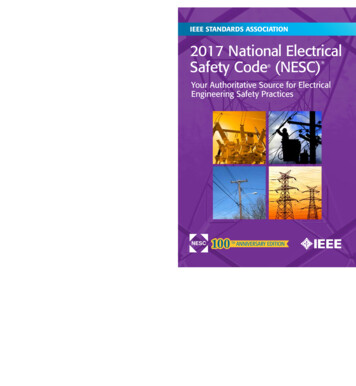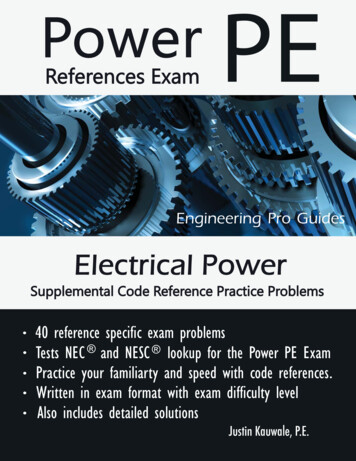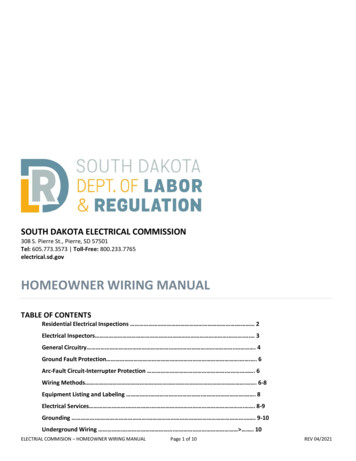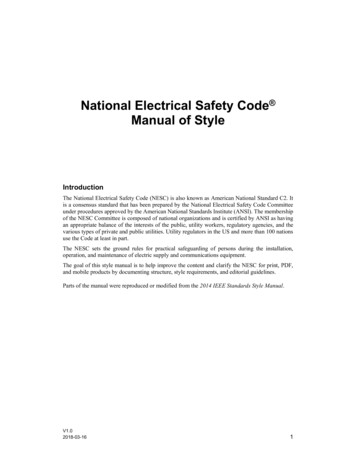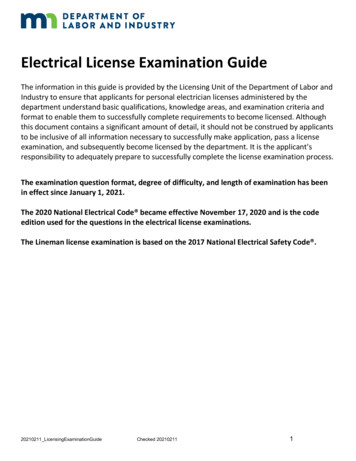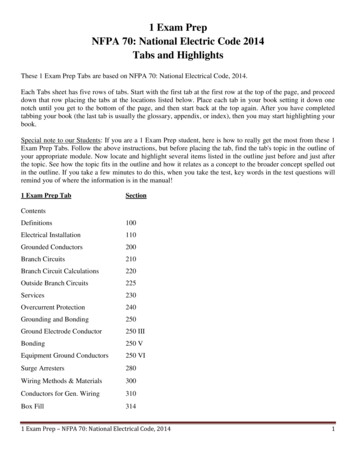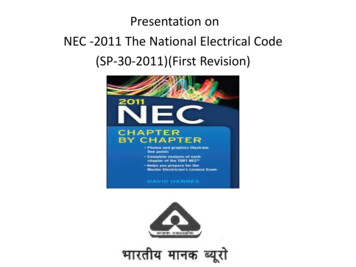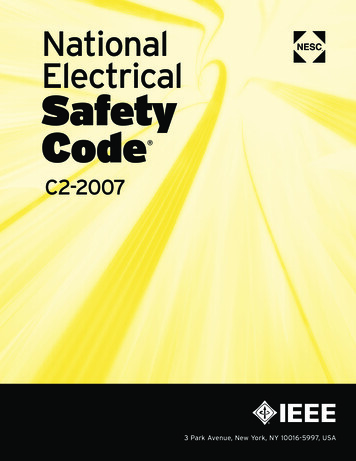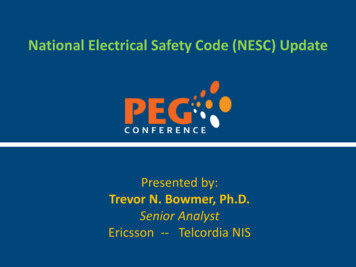
Transcription
National Electrical Safety Code (NESC) UpdatePresented by:Trevor N. Bowmer, Ph.D.Senior AnalystEricsson -- Telcordia NIS
Overview 2017 NESC Code released Code Making Process Major Relevant Changes Active Areas of Discussion Construction Blue Book (SR-1421)2
Codes inContext IEEE – NESC NFPA -- NECGO-95 .GO128 .GO165OSHA 1910.268/269Internal M&Ps GRs and UL ListingsJoint Use Agreements (JUA)ULGRs/SRsATISetc Industry Safety Codes and Standards Regulatory Rules . . Legal Mandates Internal Practices Engineering Design3
NESC Purpose& ScopePurpose The practical safeguarding of persons, utility facilities, and affectedproperty during the installation, operation, and maintenance of electric supplyand communications facilities.Scope - covers supply and communication facilities and associated workpractices employed by a electric supply, communications, or railway in theexercise of its functions as a utility. Facilities lines, equipment, and specified infrastructure (e.g., poles, vaults ) The NESC covers similar systems under the exclusive control of the utility andbeing worked by qualified persons, such as those associated with an industrialcomplex or utility interactive system.“NESC is Not a Design Guide or Instruction Manual “Personal View – However, the code is used as defacto minimum baseline to build off fordesign/engineering calculations. Extra safety factors and clearances are added to providethe highly reliable and resilient networks desired. A network designed to just meetminimum safety, clearance and strength rules is not wise network and facility planning.4.
Relevanceof NESCNESC - Adopted by most States and municipalities throughlegislative and/or regulatory (PUC) process after a review– Automatic use of latest edition.– Adoption of specific issue/date– Some do piecemeal adoption (e.g., Washington Statedoes not adopt Part 4 in entirety)– Some States have separate independent codes(e.g., General Orders 95, 128 . in California)Contractual basis of Joint-Use and Pole Agreements & InterCompany Contracts.5
Adoption& Use 90% use in some form 85% use current ornear current version(Note : Even the initial GO 95 was based onthe older NESCAutomatically AdoptsCurrently useadopts latest current NESC old Edition orNESCafter review part of NESCUses NESC to Does notdevelopuse NESCinternal codeStatusUnclear6
RevisionProcess 5-year revision schedule – plans in progress to enable accelerated changesAdministered by IEEE - Institute Electrical & Electronics EngineersTechnical decisions made by Subcommittee (SCs) based on proposalsCorrelation/Coordination – SC1, Main, Exec Committees, Standards Committee2017 Edition (released August 2016)Public change proposals (CPs) due by July 2018 NESC Working Groupsand industry discussions already underwaySC action on proposals on Sept/Oct 2018 2022 Preprint issued (Sept. 2019)Public Comments (PCs) on Preprint May 2020 action on PCs by Oct 2020Review by Main & Exec. Committees Jan-through May 2021Final Draft of 2022 NESC released May 2021 - ANSI Approval Release of2022 Code scheduled for August 2021Applies on adoption by PUC, State legislative or local AHJ bodies7
Multi-StepProcessOpen Process - Multiple Public & Internal Review StepsActive outreach efforts (IEEE) underway to add input––––Alternative energy generation and storage industry playersRegulatory commissions (PUCs)Users and Stakeholder CommunitiesWorking Groups – Industry and SC/IEEE drivenInitial Public Inputs set tone and likelydirections for code development encourages early inputAppeals Process (rare event)Adoption Variations – State by State, PUC.8
Representation(through ATIS)C2 Standards Committee - Oversight responsibility(ANSI review & Interpretation Requests6 of the 7 NESC Technical Subcommittees (not on Substations SC 3) SC1 – Purpose, Scope definitionsSC 2 – Grounding (Rules 09)SC 4 – Aerial Clearances (Rules 20-23)SC 5 – Strength/Loading (Rules 24-26)SC 7 – Underground/Buried (Rules 30-34)SC 8 – Work Rules (Part 4 - Rules 40-44)Main and Executive Committees9
MAJOR CHANGESTO 2017 CODENumerous clarifications and refinements with general objectives toimprove the practical and consistent implementation of code andharmonize rules with industry best practices and work rules Definitions - power and communications equipment & addingdefinitions for their normal allocated spaces on a pole Grounding & Bonding – Rule 094 on ground rods, Rule 096 onallowed grounding exceptions, and Rules 097 (097G) & 384pertaining to intersystem bonds Reorganization of rules (215 & 279) dealing with placement ofGuys and Insulators to better protect public and workers Grades of Construction (Section 24 – Table 242-1) Part 4 Work Rules – alignment/harmony with new OSHA Rules Arc Flash . MAD distances . Fall protection .10
Active Areas ofDiscussions Need to make NESC more flexible and responsive NESC/NEC – Demarcation & Conflicts Congestion - Management of multiple communicationsoperators/licensees Working Space Clearances Wireless FTTX Build-Outs Pole Loading Calculations Work Rules Arc Flash Risk Assessment In and around power generation and storage sites11
Drivers for NESCChanges & DiscussionsPRIMARY REACTIVE Problems, issues and conflicts revealed during active use of NESC– Joint-Use Agreement Conflicts – Wireless, Wireline, Power, Light Rail .– Problems during Engineering/Design/Planning activities– Regulatory Inspections – FCC, PUC, OSHA and AHJ Compliance– Tests & Inspections – part of routine work, planned, documented– Field incidents, accidents, and legal casesSECONDARY PROACTIVE (5 year code cycle can limit reaction time) Mismatch of new technologies to practices based on traditional codes– Wireless Antennas – Growth into Femtocells and DAS systems– Intersystem Grounding & Bonding– Alternate/hybrid sources and storage of energy – wind, solar, batteries, etc .– Smart Grid Devices – joint power and communications functions12
NESC EquipmentDefinitions Electric Supply Equipment. - Equipment that produces, modifies, regulates,controls, or safeguards a supply of electric energy for the electric powersupply grid that is (1) transferred to supply lines, or (2) used to providepower and/or control for other electric supply equipment, or (3) used toprovide power to the devices of another utility.NOTE: Electric supply equipment does not include equipment whose purpose is toprovide power to support locally mounted communication systems. For example,power supplies supporting CATV or communication amplifiers or repeaters are notconsidered to be supply equipment. Communications Equipment. - Equipment that produces, modifies,regulates, or controls communication signals. This equipment may alsoproduce, modify or safeguard a supply of electric energy for the exclusiveuse of communication devices as long as the equipment andcommunications devices being served are owned and operated by the sameparty .These definitions are in harmony and consistent with those inthe NEC. Both codes recognize that communications equipmentcan include servers and routers and their powering supplies.13
SpaceDefinitionsSafety forworkers (both)Safety throughSeparationGround clearanceSafety for Public14
Demarcation15
DemarcationBetween CodesElectrical Supply . TelecommunicationsService Points . .Network Interface****Utility Defined Demarcation Point****– At Residence – Network Interface Device or Unit (NID or NIU)/Optical Network Unit (ONU) Outside of house . AC Panel inside house– Commercial Building Building Entrance Terminal (BET – inside or outside) . Telecom Closet or RoomAC Panel or power Room inside building– Communications Nodes - Electronic Hut or Cabinet or Active Fiber Hub– Closure Inside Hut– Distinct AC compartment in cabinet or separate adjacent box– Lighting for Parking Area– Long Rural line serving Remote Farm or Residence At Main Road .At Property Boundary .At Buildings– Distributed/Alternate Power– Solar/Wind farms, Microgrids . Interconnection to power Grid . Smart Grid Devices– Line and span powering16
Modernize & KeepCode Up to DateCode needs to keep up with technological change and IoT WorldInternal Code Issues – mostly driven by IEEE– On line tools and internet delivery of codes, guidance and services- MOOCs (Massively Open Online Courses) .– Outreach to old and new stakeholders through NESC summits and workshops– standards.ieee.org/about/nesc www.standardsuniversity.org/videos– Interim code change processes – shorter turn-around timesExternal – Joint use agreements and relations between companies and with PUCs Congestion and Conflicts – Technical & Commercial - on structures andunderground– Traditional stakeholders are the Power and Incumbent Communications (ILEC)Utilities plus usual suspects of railroads, Light Rail, suburban subway transit,and (DoT) traffic control/monitor devices– Competitive LECs (CLECs) and Wireless Companies Subsidiaries of ILECs and CLECs Newcomers (Google Fiber, )– Distributed/Alternate sources of energy – wind, solar, microgrids, etc . Smart Grid Devices – joint power and communications functions17
Grounding& Bonding2017 NESC Changes :Rule 096 – Exception to 4 grounds per mile added toaccommodate long spans under water, across valleys, etc Rule 097 – Bonding between power and communications (097G)Rule 384C (Part 3 - Underground Lines) – add Note “This rule doesnot prohibit bonding communication metallic enclosures to supplypole grounds provided all affected parties are in agreement.”Open Issues :Rule 094B – Ground Rod Materials and sizes– Galvanized Steel versus Copper Clad Steel– Trade versus actual sizesRule 099 – Intersystem Bonding at House (Demarcation Point)– 14 AWG versus 6 AWG18
Rule 097 – Grounding& Intersystem BondingRule 097 has 7 interlocking subsections with implicit/explicit links to otherRules (e.g., 096, 224, 344, 354, 384) applicable to intersystem bonds Rule 097A -- separate grounding conductors Rule 097B – permits a bond to the power ground where a MGN system isbeing used and providing Rule 097C (i.e., 4 grounds/mile) is met. Rule 097C - 4 grounds/mile criteria helps define an effective ground Rule 097G requires a single grounding conductor on structures except asrequired by Rule 097ATelcordia supported the revision as an improvement and clarification Sets expectation that bond to vertical ground should be madeunless explicit technical reason exists not to bond Clarifies the relationship between 097G and other subsectionsof Rule 097 by placing the criteria in explicit Exceptions.Further editorial improvements may help – under review.19
Rule 097G2017 Language2017 NESC G. Bonding of communication systems to electric supply systemsWhere both electric supply systems and communication systems are groundedon a joint use structure and a single grounding conductor is present, thegrounding conductor shall be connected to both systems. Where separatesupply and communications grounding conductors are used, they shall bebonded together.Exception 1: Where separation is required by Rule 097AException 2: Where the electric supply utility is maintaining isolationbetween primary and secondary neutrals, the communication system groundshall be connected only to the primary grounding conductor if it complieswith the requirements of Rule 097C.20
IntersystemBonding (097 & 099) Rule 097 – Bonding Power and Communications Grounds– Bond to power ground or MGN, if possible– Alternates - Single ground rods or Ground beds (3 rods) orbond to reinforced concrete vaults may be needed– Bond grounding systems together if within 6 feet Rule 099 – Intersystem Bonding at House– Choices – NEC versus NESC– Intersystem bond near meter box or point of entrancefollowing Chapter 8 (e.g., 800.100 or 250.94 on the IBT)– 6 AWG copper preferred (smaller gauges 6 AWG to 14 AWGare possible inside the equipment)– Single ground rod at house If earth connection is notadequate or effective, then add one extra rod (bonded).21
CONGESTION22
NESC Part 2Aerial Plant Space Definitions (previous discussions) Clearances between communications lines Rule 235H––––12 inch minimum separation at support4 inch minimum anywhere in span (spacers?)Under all ambient conditions (all expected conditions)Wording of final rule may need revision during next cycle period Wireless (Antenna) Attachment – Rule 235I clarified– All other clearances need to be met as facilities are attached tocongested poles with multiple communications and power facilities– Engineering designs and configurations Blue Book and other designand engineering guidance documents. Clearance between communications and supply facilities – Rule 238– Encourages grounding of supply equipment by having larger (40 inch)separation for ungrounded supply equipment23
Clearance &Separation24
Powering Circuitsfor CommunicationsModern communications cables can include power supply circuits forPower-over-Ethernet (PoE), span/line powering applications and to providefor other communications devices (e.g., antenna). Requiring eachconductor of a supply circuit used exclusively to power communicationsdevices to be “individually enclosed with an effective shield” is notnecessary. Having additional shields around each individual conductor doesnot add significantly to the safety of the circuit or cable configuration. SC4 Rule 224B2(a) – Aerial cables SC7 Rule 344A1– Underground/Buried Cables25
Powering Circuitsfor CommunicationsThe configurationto the right hasindividual shieldsand complies with2012 NESC.This is an older hybrid cable design thatis a power cable which had 480 V poweron the 1/0 AWG conductors as well assome communications conductors in thecenter portion.The safety concerns on the use of thistype of hybrid power cable was thereason that this 224B and 344 rule wasfirst created.The objective for the NESC change was topermit the safe shielding variation shownbelow for span powering or line poweringapplications over small gauge twisted-pair (1924 AWG) conductors. These are much lowervoltage and power level circuits then the 480 Vpower cable shown to the left.This hybrid construction does require theindividual shield/ground for each 1/0AWG conductor for safety reasons.26
GuysInsulators Rule 215 - Guys and Guy insulators Effectively grounded .Connections through hardware Objective is that if guys are slack or broken, the guys donot create hazard to public .Reference height is 8 ft Protect both Public on ground and workers in aerial plant2727
Pole LoadingConstruction Grades Construction Grades – Reorganized & Clarified (Table 242-1)– More clearly define where and when each Grade isapplicable– Grade N used for temporary & emergency work, privaterights of way and service drops– Grade B highest grades – for joint use & railroad crossings– Grade C most often for communications poles Open Issues – for resolution or continued work Next Cycle– 60 foot exemption – Retained– “K additive constant” - Retained for presentbut expected to eventually be replaced withnew ice/wind loading factors and addition ofNon-Linear Design methods in next code cycles.28
Work Rules(NESC Part 4)SC8 – Work Rules (Part 4 : Sections 40-to-44) NESC changes partly in response to 2014 OSHA release of newelectrical worker rules under 29 CFR 1910.269, “Electric PowerGeneration, Transmission, and Distribution” Arc Flash PPE & Risk Assessment - Rule 410A3– OSHA . IEEE 516 NFPA 70E Minimum Approach Distances (MAD) - Rules 431 and 441– OSHA . IEEE 516– Reach and Extended reach – with/without tools Fall Protection - Rules 411F and 420K– OSHA 1910.268/269– 420J – Ladders and supports29
Arc-FlashArc Flash PPE & Risk Assessment – Rule 410A3 Rule strongly encourages that a Hazard Risk Assessment becompleted otherwise default PPE is required– NESC 410 A3 . OSHA . IEEE 516 NFPA 70E– Harmonized mostly with equivalent safety results Default DC limits –– 50 V to 250 V and up to 8000 amps use 5 cal/cm2 PPE Engineering Controls Best Practices (M&s)– “NOTE 5 : Engineering controls can be utilized to reduce arcenergy levels and work practices can be utilized to reduceexposure levels.” Telecommunications Circuits are inherently safe – GR-1089 and ATIS0600315 standards limit voltages & currents.30
FallProtection Fall Protection . NESC 411F & 420K & 420J– Fall Prevention versus Fall Arrest– Activates at working heights above 4 ft instead of 10 ft– “Climbing to” or Transferring versus “at Working” position– Prohibitions 100% leather positioning straps Non-locking snaphooks.420J – Ladders and supports Support needs to be “adequately strong, in good condition, and properlysecured in place”420J1 - Employees shall not support themselves, or any material orequipment, on any portion of a tree, pole structure, scaffold, ladder,walkway, or other elevated structure or aerial device, etc., without it firstbeing determined, to the extent practical, that such support is adequatelystrong, in good condition, and properly secured in place.31
Energy StorageBatteries Rule 420G – Liquid cell Batteries – (Section 14)–––––Keeping up with new battery technologies Liquid ?Lead-Acid, Lead-Calcium VRLA type systems Lead-SeleniumNi-Cd (Nickel-Cadmium) Ni-MH Nickel Metal HydrideNa-Ni-Cl Sodium Metal Hydride, sodium-sulfurZn-Br, Zn-air, Li-ion – lithium ion technologies – variety of chemistriesGrowingvarieties Related Issues for Part 1 (Substations)– Distributed power and alternate energy sources– Solar and Wind Farms, Microgrids, fuel cells, etc Larger Sizes32
Paths ForwardActive Support and Monitoring Activities Propose and support clarifying revisions to bonding Rule 097G Improve clarity of 235H clearances between communications lines Monitor discussions on pole loading– Support retention of Grade N & 60 ft exemption– Monitor “K additive Constant” debate to help ensure consistency Monitor GO 95 activities for new ideas to avoid or those to emulate Support OSHA harmonization efforts for improvements inarc flash, fall protection, MAD – NESC Part 4 Support new revision to Battery rule 420 G (WG leader) Construction Blue Book – Issue 6– Wireless Facility Issues33
SR 1421Issue 6Blue Book – Manual of Construction ProceduresChapter 1Chapter 2Chapters 3 to 14Chapter 15Chapter 16 to 20Chapter 21 to 24Chapter 25Chapter 26Chapter 27Chapter 28AppendicesOverviewGeneralAerial PlantWireless Facilities (NEW)Underground PlantBuried PlantBonding & Grounding – Customer LocationsCable GuardsFiber Optic Facilities (FTTX) - DeploymentSymbols – Grid and Mapping DiagramsInformational Commentaries34
SR 14212017 - Issue 61. Size - 500 pages 38% increase in size2. Harmonize with latest NESC and NEC national safetycodes.3. Commentaries and clarifications added based on fieldproblems, issues, and concerns over previous 6 years.4. New Wireless Chapter (Chapter 15) and incorporation ofwireless facilities information in other chapters5. Updated Fiber Optic network (FTTX) - Chapter 276. Expanded guidance and details on Grounding andBonding issues – primarily in chapters 10 and 2535
THE ENDThanks forYour Attention36
Blue BookChanges OverviewScope & General SafetyChapter 1 Introduction - expanded commentary on scope and purpose and howspecifications, codes and standards fit together to help create reliable, resilientnetworks.Chapter 2 – General – New/Revised sections include– 2.1.2 – Make-safe or Made-Safe– 2.1.3 - MAD values – small minor changes– 2.1.4 - Use and Maintenance of Rope– 2.2.1 - Powering of communications equipment– 2.2.2 - Electric Safety of Communications Circuits - Arc Flash– 2.10.1 - Steam lines– 2.14 - Wireless Facilities– 2.17 – Personal protection Equipment (PPE) – gloves37
Aerial PlantChap 3 - 7Chapter 3 – Aerial Clearances – Revised/Updatedsections3.2 - Clearances – updated and clarified per NESC3.7 - Communications Antennas – now new Chap 153.8.1 – Pole placement relative to roadway and use ofreflector markers3.10 - Service Drop masts guidanceChapter 4 – Strand - various parts of 4.1 to 4.5 sectionswere revised, corrected and updated. New applicationcommentary (Sec. 4.6) covering different strand size andmaterial choices as well as needs for coastal regions.Chapter 5 –Pole Line Hardware –Chapter 6 – GuyingChapter 7 – Insulating GuysThese Chapters 5-7 had various sections were revised, corrected and updated in general waysto clarify guidance or update with latest NESC (Rule 215C for Insulating Guys) and crossreferences to latest Telcordia GRs and relevant industry standards.38
Aerial PlantChap 8 - 11Chapter 8 – Anchors and Guy Rods - expanded discussion on anchor types, anchor rodpositioning, with new– 8.9 - Anchor verification – position and strength– 8.10 - Removal of anchor/rodsChapter 9 – Suspension Strand – False Dead Ends and Slack Spans - Figures wererevised, updated and corrected with commentary added to clarify the networkapplications for these configurations.Chapter 10 – Bonding and Grounding in Aerial Plant - Sections were added to expandon the objectives of, and rationale to, changes to NESC Rule 097 and 384. Chapter 10material was correlated with other related grounding and bonding issues discussed innew Chapter 15 (Wireless) and Chapter 25 (Grounding & Bonding at CustomerPremises).Chapter 11 – Identification in Aerial Plant - Doubled the size of the chapter andexpanded descriptions and choices for aerial markers of cable plant, guy markers andother identification for aerial plant along with cross references to othermarking/labeling requirements for facilities - for the pole (Chapter 12) and for wirelessequipment (Chapter 15).39
Aerial PlantChap 12 - 14Chapter 12 – Pole Testing and Inspection - updated the chapter with numerouschanges to better match current up-to-date practices and approaches withpole inspection programs.Chapter 13 – Pole Loading and Strength Requirements - Pole Loading thestrength overview - The chapter was revised with explanatory commentary onlatest changes in NESC and expanded discussions of the design and engineeringfactors that need to be considered. Applicable construction grades and poleloading stresses are discussed.Chapter 14 – Supply Equipment in or Near the Communications Space - Thechapter was revised and updated with several changes with added crossreferences on power supply boxes and with the new wireless Chapter.40
New WirelessChapter 15Chapter 15 - Wireless Facilities - This new chapter covers wireless issues suchas RF exposure and appropriate/recommended locations for wireless antennaeand support facilities on joint-use structures including– 15.1 – Overview of wireless components and regulatory areas– 15.2 – RF Exposure - Pole Markings and Labels– 15.3 – Pole Marking– 15.4 – Mechanical, Electrical and spatial concerns for joint use on polesWorking Space Climbing Space Electrical Safety– 15.5 – Locations choices - antenna on poles – cross arms Wireless concerns are also covered in –– Clearances – Chapter 3– Grounding/Bonding – chapters 10 and 25– Powering of equipment – chapter 14– GR-3171 (Wireless Infrastructure), GR-3178 (WiTF facilities)– Support hardware/cabling - GR-3174, other GRs & Industry Standards41
Buried &Underground Plant42
UndergroundChap 16 - 20Chapter 16 – General precautions and Work Rules for Manholes– Added details on Handholes, smaller vaults , corrosion in manholesChapter 17 – Testing Manhole Atmosphere and Ventilating Manholes– Small additions and corrections made throughout the chapter to helpclarify issues and expand on some of the issues already covered.Chapter 18 – Bonding Cables in Manholes and Handholes - expandeddiscussions to better cover HandholesChapter 19 – Identification Markers for Underground Cable - new Section19.6 added covering a discussion on Locating Technologies for Buried andUnderground PlantChapter 20 – Sealing Conduits and Ducts - expanded discussions to includemicroduct products, revised listing of commercial sealants and pluggingmaterials, added triplex/Multi-plex split plugs discussion and different tapesused in conduit facilities.43
Buried PlantChap 21 - 26Chapter 21 – Buried Plant Construction - enhancements and clarifications to buriedplant issues on GR-902 handholes, and application notes.Chapter 22 – High-Speed, Blown Cable Installation System - Minor revisions mostlyplus new information and calculations for cable placement distances able to beaccomplished with the HASB systems.Chapter 23 – Direct Buried Innerduct Construction Guidelines - Minor revisions mostlyplus new information on Microtrenching (23.4.4)Chapter 24 – Directional Drilling (HDD) - Minor revisions mostly plus new informationand calculations in Sec 24.7 for predicted Mini-HDD Pull Load vs. Safe Pull distanceChapter 25 – Bonding and Grounding – Drop Cables & Service Wires - Revised tomatch latest NESC and NEC changes and has been expanded to include design andengineering guidance on grounding/bonding at the customer premises NID(demarcation points).Chapter 26 – Cable Guards – Vertical risers - Minor revisions and enhancements withadded discussion of transition cable between buried and aerial plant44
FTTX Chap 27Informative ChaptersChapter 27 – Fiber Optic (FTTX) - Was updated and revised in general for fiberoptic networks and with information on Flexnap type cables and microductusage.Chapter 28 – Symbols for Grid and Mapping Diagrams - Minor revisions,Appendices updated and revised– Appendix A – Loading Maps in NESC - NESC commentary on clearances, poleloading/strength and related geographical zones and districts– Appendix B – NESC commentary on active issues in NESC technicalsubcommittee discussions and those that are expected to cause changes nextcycle.– Appendix C – Historical reference material - 1911 Rules for Troublemen– Appendix D – References45
NESC Purpose & Scope Purpose The practical safeguarding of persons, utility facilities, and affected property during the installation, operation, and maintenance of electric supply and communications facilities. Scope - covers supply and communication facilities and associated work practices employe
